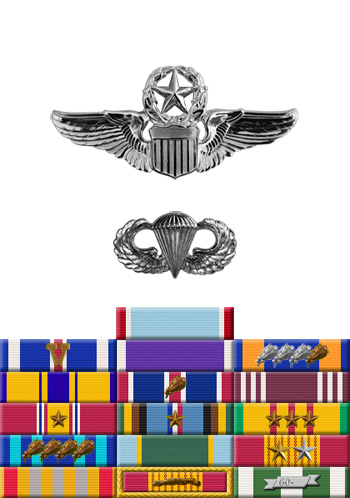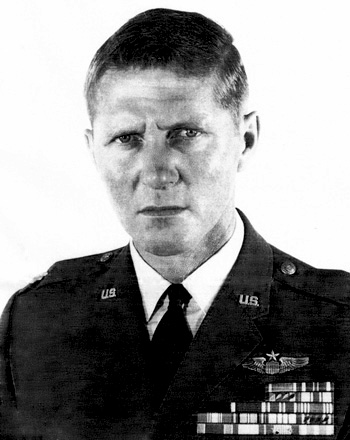Delbert Fleener was born on March 1, 1929. He enlisted in the U.S. Air Force on June 12, 1951, and was trained as a weapons specialist before entering Pre-Flight Training on December 21, 1953. He entered the Aviation Cadet Program on April 9, 1954, and was commissioned a 2d Lt and awarded his pilot wings at Vance AFB, Oklahoma, on March 30, 1955. After completing additional training, he served as a KB-29 tanker pilot with the 622nd Air Refueling Squadron at England AFB, Louisiana, from December 1956 to October 1960, when he transferred to the 421st Air Refueling Squadron at Yokota AB, Japan. Fleener then served as a C-118 Liftmaster pilot with the 48th Air Transport Squadron (ATS) at Hickam AFB, Hawaii, from October 1962 to November 1964, and then with the 38th ATS at McGuire AFB, New Jersey, from November 1964 to September 1965. He served as an O-1 Bird Dog pilot with the 19th Tactical Air Support Squadron at Bien Hoa AB in the Republic of Vietnam from September 1965 to March 1966, and then as a C-118 pilot at Tan Son Nhut AB until May 1966, when he transferred to Hickam AFB, Hawaii. Maj Fleener served with the 6486th Operations Squadron at Hickam from May 1966 to April 1968, and then returned to Southeast Asia, where he served with the 6250th Support Squadron at Tan Son Nhut AB until 1970. Maj Fleener retired from the Air Force on May 19, 1972. Delbert Fleener died on May 28, 2010.
His Air Force Cross Citation reads:
Captain Delbert W. Fleener distinguished himself by extraordinary heroism in connection with military operations against an opposing armed force near the District of Binh Duong, Republic of Vietnam, on 17 December 1965. On that date, Captain Fleener was diverted from his original target to search for a pilot who had been shot down over hostile held territory. With complete disregard for his personal safety, and though exposed to an intensive barrage of small arms, automatic weapons and antiaircraft fire, Captain Fleener continuously flew his aircraft at extremely low altitude over the hostile positions in an effort to locate the downed pilot. The wreckage was sighted and almost entirely hidden by hostile forces attempting to camouflage the plane. With only four rockets, Captain Fleener made repeated low passes over the wreckage, firing one rocket on each pass. This daring and aggressive attack by Captain Fleener caused the hostile forces to disperse temporarily and denied them access to secret material and valuable radio equipment. After expending his ordnance, he landed his badly damaged aircraft on a nearby airstrip to refuel and rearm his aircraft. After returning to the area, he provided air cover for a helicopter crew which was attempting to discover the fate of the downed pilot. Although wounded in his right leg and in great pain, Captain Fleener continuously provided protection for the helicopter for over thirty minutes before being ordered to leave the area. While fighting off loss of consciousness, Captain Fleener successfully flew his crippled aircraft into a remote airstrip and landed without further incident. The extraordinary heroism, superb airmanship, and aggressiveness demonstrated by Captain Fleener reflect the highest credit upon himself and the United States Air Force.
|



